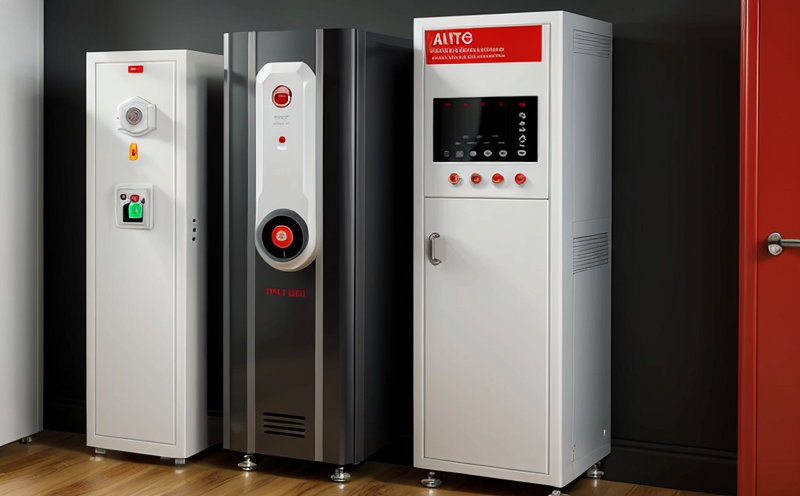UL 521 Heat Detectors Testing
The UL 521 standard is a crucial component in ensuring that heat detectors meet stringent performance and safety requirements. These devices play a critical role in fire safety systems, providing early detection to mitigate the risks associated with fires. This service involves comprehensive testing of heat detectors according to the criteria set by Underwriters Laboratories (UL). The UL 521 standard covers both cable-type and pendant-type heat detectors designed for use in buildings where early warning is essential.
The testing process begins with a thorough understanding of the device's intended application. This includes assessing the environmental conditions, such as ambient temperature ranges and potential contaminants that may affect performance. Specimen preparation involves ensuring that the detector meets all specified dimensions and materials requirements before undergoing tests. The UL 521 heat detectors are subjected to various environmental stressors to evaluate their resilience against common fire scenarios.
One of the primary aspects of this testing is the evaluation of the detector's response time under different temperature conditions. This involves exposing the device to a series of calibrated thermal events, ranging from slow-rise temperatures to rapid-rise conditions, to determine its sensitivity and reliability. The detectors are also tested for their ability to distinguish between actual fires and other sources of heat, such as cooking or smoking, which is critical in preventing false alarms.
The testing process includes both laboratory simulations and real-world scenario evaluations. For instance, the devices may be exposed to controlled environments that mimic the conditions found in various types of buildings, including residential, commercial, and industrial settings. This approach ensures that the detectors perform consistently across different applications. Additionally, the UL 521 standard requires testing for durability under continuous operation, ensuring long-term reliability.
Another key aspect of this testing is the evaluation of the detector's signaling mechanisms. This includes checking the integrity of the electrical connections and verifying that the device can effectively communicate with other components of the fire alarm system. The UL 521 standard also specifies requirements for the visual and audible outputs, ensuring that the signals are clear and easily recognizable to personnel.
The testing process also involves assessing the detector's ability to withstand environmental factors such as humidity, dust, and vibrations. This ensures that the device remains functional even in challenging conditions, which is essential for maintaining fire safety standards in various environments. Furthermore, UL 521 heat detectors are tested for their response time under different temperature conditions, ensuring they can detect fires promptly and accurately.
The comprehensive nature of this testing ensures that only reliable and effective heat detectors reach the market. This service not only guarantees compliance with industry standards but also enhances overall fire safety by providing devices that perform predictably in critical situations. The UL 521 standard is widely recognized for its rigorous requirements, making it a gold-standard benchmark for quality and performance.
Benefits
Compliance with industry-leading safety standards, ensuring reliable performance in real-world conditions.
Promotes trust among stakeholders by demonstrating adherence to stringent quality control measures.
Reduces liability risks associated with non-compliant products by meeting all regulatory requirements.
Enhances brand reputation and marketability through the display of UL certification.
Achieves greater operational efficiency by ensuring that fire detection systems operate without interruption or failure.
Facilitates smoother compliance with international standards, including ISO 9001 for quality management systems.
Quality and Reliability Assurance
The UL 521 heat detectors testing service is designed to uphold the highest standards of quality and reliability. Our team employs state-of-the-art equipment and follows strict protocols to ensure that every detector meets or exceeds the specified performance criteria. The testing process includes rigorous calibration, environmental stress testing, and real-world scenario evaluations to simulate actual fire conditions.
Our commitment to quality extends beyond just meeting regulatory requirements. We work closely with our clients to understand their specific needs and provide tailored solutions. This ensures that the detectors not only comply with UL 521 standards but also perform optimally in the intended application. By adhering to these stringent testing protocols, we help manufacturers produce products that are reliable, safe, and effective.
The results of our testing are documented meticulously and reported comprehensively. These reports provide detailed insights into each detector's performance, highlighting any areas for improvement or enhancement. Our team is also available to offer expert advice on best practices for product development and optimization. Through this service, we contribute significantly to the overall quality assurance framework in fire safety systems.
Environmental and Sustainability Contributions
The UL 521 heat detectors testing service not only enhances fire safety but also contributes positively to environmental sustainability efforts. By ensuring that fire detection devices are reliable and effective, this service helps minimize the risks associated with fires, which can lead to significant environmental damage.
Reliable fire detection systems play a crucial role in reducing the spread of fires and minimizing the need for extensive firefighting operations. This, in turn, reduces the carbon footprint associated with firefighting efforts and resource consumption. Furthermore, by promoting the use of high-quality, long-lasting detectors, this service helps reduce waste and promote recycling practices.
The UL 521 standard also emphasizes energy efficiency, which contributes to a more sustainable built environment. By ensuring that fire detection systems operate effectively without unnecessary power consumption, we help promote the use of energy-efficient technologies in building design and construction.
Through our commitment to quality and reliability, this service supports broader sustainability goals by enhancing safety standards and reducing environmental impact. Our clients benefit from reduced operational costs, enhanced reputation, and a clear conscience knowing that they are contributing positively to global sustainability efforts.
Frequently Asked Questions
- Enhanced safety for building occupants by providing reliable early detection.
- Achieving market access in regions that require UL certification.
- Meeting insurance requirements and potentially qualifying for premium discounts.
- Promoting brand reputation through adherence to high standards of quality and reliability.





